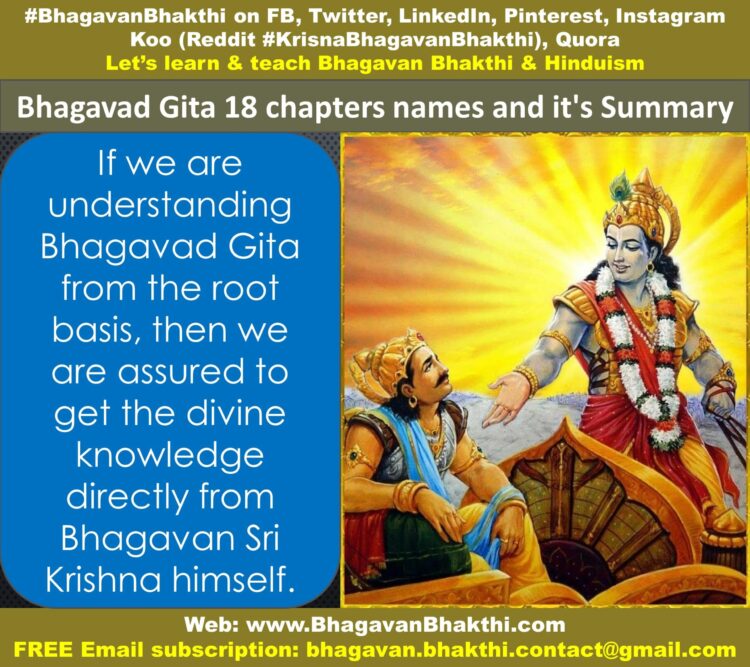List of Bhagavad Gita 18 Chapter Names with Meaning | Summary of 18 chapters of Bhagavad Gita | What is the meaning of chapter 18 of the Bhagavad Gita? | Why Gita has 18 chapters? | How many parts does Bhagavad Gita have? | How many verses are there in Bhagavad Gita chapter wise?
Namaste friends, how are you doing today? Welcome to #BhagavanBhakthi website / blog.
Bhagavan Lord Sri Vishnu (Krishna, Rama, Trivikrama, Narasimha, Vamana, Vasudeva, Mukunda) and Goddess Lakshmi (Rukmini, Satyabhama, Sita, Kamala, Maya) blessings to you and your family!
In this website / blog, you will always learn about #Hinduism #Sanskrit language.
Also subscribe to my YouTube channel from this link #BhagavanBhakthi to view videos about #Hinduism #Sanskrit language.
Just before going to “List of Bhagavad Gita 18 Chapter Names with Meaning | Summary of 18 chapters of Bhagavad Gita | What is the meaning of chapter 18 of the Bhagavad Gita? | Why Gita has 18 chapters? | How many parts does Bhagavad Gita have? | How many verses are there in Bhagavad Gita chapter wise?“, let us know a brief, basic and very important information.

Bhagavad Gita, the two words Bhagavad + Gita looks so divine.
Bhagavad Gita means, Bhagavan Sri Vishnu in his avatar as Bhagavan Sri Krishna himself speaking in the form of Gita. That is, he himself is singing (Gita) the whole of Bhagavad Gita for the upliftment of the mankind.
Here Bhagavad Gita = Bhagavad + Gita = Bhagavan Sri Krishna + Singing. Bhagavad Gita is one of the most revered grantha (Hindu divine book) for the humanity.
If we are understanding it from the root basis, then we are assured to get the divine knowledge directly from Bhagavan Sri Krishna himself. Bhagavan Sri Krishna has given us the gift in the form of song and it is in simple style, easy to understand.
With the support of a correct Vaishnava Guru (Someone who has come in the Vaishnava Guru Parampara whose first Guru is Sri Veda Vyasa Deva / Sri Vishnu).
Dear friends, first let us know the Bhagavad Gita 18 chapter names and then later on, we will know the meaning of each of the chapter.
List of Bhagavad Gita 18 chapter names are as given below:
Chapter 1 : Vishada Yoga – Total 46 slokas | Chapter 2 : Sankhya Yoga – Total 72 shlokas | Chapter 3 : Karma Yoga – Total 43 slokas | Chapter 4 : Jnana Yoga – Total 42 shlokas |
Chapter 5 : Karma Vairagya Yoga – Total 29 shlokas | Chapter 6 : Abhyasa Yoga – Total 47 slokas | Chapter 7 : Paramahamsa Vijnana Yoga – Total 30 shlokas | Chapter 8 : Akshara-Parabrahman Yoga – Total 28 slokas |
Chapter 9 : Raja-Vidya-Guhya Yoga – Total 34 shlokas | Chapter 10 : Vibhuti-Vistara-Yoga – Total 42 slokas | Chapter 11 : Vishwaroopa-Darshana Yoga – Total 55 shlokas | Chapter 12 : Bhakti Yoga – Total 20 slokas
Chapter 13 : Kshetra-Kshetrajna Vibhaga Yoga – Total 35 shlokas | Chapter 14 : Gunatraya-Vibhaga Yoga – Total 27 slokas | Chapter 15 : Purushottama Yoga – Total 20 shlokas |
Chapter 16 : Daivasura-Sampad-Vibhaga Yoga – Total 24 shlokas | Chapter 17 : Shraddhatraya-Vibhaga Yoga – Total 28 slokas | Chapter 18 : Moksha-Upadesha Yoga – Total 78 shlokas

Bhagavad Gita clearly explains the blissful revered philosophy of everyone’s duty. This revered philosophy of duty is clearly based on realistic worldview, and monotheistic view of Dharma.
Bhagavad Gita is described as Brahmavidya and Yogashastra i.e. a book that gives knowledge, and also teaches the means to attain it.
One should always try to understand the inner and root meaning of Bhagavad Gita. Just like humans have skin with 7 layers of ectodermal tissue and guards the underlying muscles, bones, ligaments and internal organs,
similarly if we understand the inner and root meaning of Bhagavad Gita, we are definitely assured of winning both material actions and spiritual paths.
But we as ordinary humans can see only the upper layer and have less or no idea about the inner layers of the skin, that is, we are not sure about the inner and root meaning of the Bhagavad Gita.
For this, we need to look for a correct Vaishnava Guru to understand the inner and root meaning of the divine Bhagavad Gita.
Bhagavad Gita’s knowledge enables one to realize the following facts, which are highly relevant to the people of Kali Yuga:
1. The atma (Divine soul) is eternal and only the body is destroyed. | 2. Because of the attachment to the bodies, etc., that causes the grief. | 3. Whether it is pleasure and pain, one should discharge one’s duties unmindfully. |
4. All are completely dependent upon Bhagavan Sri Vishnu / Krishna. Only he is Sarvottama / Supreme and regulator of all in the unlimited Universes. It is the realization of this fact that removes attachment, which is the root cause of all pain, misery etc.
Srimad Bhagavad Gita totally consists of 18 chapters. Every chapter is known as a ‘Yoga‘. Yoga is the science of the individual consciousness attaining communion with the Sarvottama / Supreme Bhagavan Sri Vishnu / Krishna.
Thus, each chapter is a highly specialized Yoga revealing the path of attaining realization of the ‘तत्त्व / ತತ್ತ್ವ / tattva’ / ‘Ultimate Truth’. The first six chapters have been classified as ‘Karma Yoga’ section,
as they mainly deal with the science of the individual consciousness attaining communion with the Ultimate Consciousness, that is, Bhagavan Sri Vishnu through Karma / actions.

Now, let us take each chapter to know about it briefly:
List of Bhagavad Gita 18 chapters names with meaning are as given below:
Chapter 1 : Vishada Yoga – Total 46 slokas – Chapter one introduces the scene, the backdrop, the situation and the characters involved in determining the reasons for the Bhagavad-Gita’s disclosure.
The scene is the sacred plain of Kuruksetra. The backdrop is a battlefield. The situation is war.
The main characters are the Sarvottama / Supreme Bhagavan Sri Krishna and his very close friend Arjuna, witnessed by four million soldiers led by their respective military commanders.
After naming the main warriors on both Kaurava and Pandava sides, Arjuna starts growing dejection in the war, and this chapter described the fear of losing his very close friends and relatives in the course of the upcoming war and the subsequent sins attached to such Karmas / actions.
Thus this chapter is named as Vishada Yoga (Lamenting on the result of War).
Chapter 2 : Sankhya Yoga – Total 72 shlokas – In this chapter, Arjuna accepts the position as a disciple of Bhagavan Sri Krishna and requests Bhagavan Sri Krishna to inform him in how to eliminate his lamentation and misery.
This chapter is often considered as a summary to the entire Bhagavad-Gita. Here multiple subjects are explained, that is, ‘Karma Yoga’, ‘Jnana Yoga’, ‘Sankhya Yoga’, Buddih Yoga’ and the atma (Divine soul).
Importance has been given to the immortal nature of the atma (Divine soul) existing within all living entities and it has been described intensively. Thus this chapter is named as “The Eternal Reality of the atma’s immortality”.

Chapter 3 : Karma Yoga – Total 43 slokas – Chapter three sets up the reality by various points of view that the performance of prescribed duties is compulsory for each and everyone.
No one can turn their back by not doing their prescribed ‘Dharmas’ (Duties). Each and every person has his / her own prescribed which he / she has to perform at any cost.
Here Bhagavan Sri Krishna resolutely and comprehensively explains how it is the duty of each and every member of society to carry out their functions and responsibilities, in their respective stage of life according to the Dharma (Rules and regulations) of the society in which one lives.
Further, Bhagavan Sri Krishna explains: Why such duties must and should be performed? | What benefit is gained by performing them? | What harm is caused by not performing them? Plus,
What actions lead to bondage and what actions lead to moksha / mukti / divine salvation? | All these important points relating to Dharma / duty have been described robustly.
Thus this chapter is named as “Karma Yoga” / The Eternal Duties of Human Beings.
Chapter 4 : Jnana Yoga – Total 42 shlokas – In this divine chapter, Bhagavan Sri Krishna reveals how adhyatmic knowledge (Divine spiritual knowledge) is received by discipled succession and the reason and nature of His (Bhagavan Sri Krishna’s) descent into the bhoutika / material worlds.
Here Bhagavan Sri Krishna also clearly explains the paths of action and knowledge and as well as the wisdom regarding the Sarvottama / Supreme knowledge which results at the culmination of the two paths.
Thus this chapter is named as “Jnana Yoga” / Approaching the Ultimate Truth.

Chapter 5 : Karma Vairagya Yoga – Total 29 slokas – Here, Bhagavan Sri Krishna describes’ the concepts of action with “Vairagya” / detachment and renunciation in actions explaining that both are a means to the same goal.
Also, here Bhagavan Sri Krishna explains how salvation is attained by the pursuance of these paths. Thus this chapter is named as “Karma Vairagya Yoga” / Detachment and Renunciation.
Chapter 6 : Abhyasa Yoga – Total 47 shlokas – In this chapter, Bhagavan Sri Krishna reveals ‘ashtanga yoga’ (Eight parts), and the exact process of practicing such yoga.
Bhagavan Sri Krishna describes in detail the difficulties of the mind and the procedures by which one may gain proficiency of their mind through yoga, which reveals the adhyatmic / spiritual nature of a living entity.
Thus this chapter is named as “Abhyasa Yoga” / The Science of Self-Realization.
Chapter 7 : Paramahamsa Vijnana Yoga – Total 30 slokas – In this chapter seven, Bhagavan Sri Krishna gives real information of the absolute reality and as well as the opulence of divinity.
Bhagavan Sri Krishna explains His illusory energy in the material existence called Maya and declares how extremely difficult it is to surmount it.
Bhagavan Sri Krishna also explains the four types of people attracted to divinity and the four types of people who are opposed to divinity.
In conclusion, Bhagavan Sri Krishna reveals that: One in adhyatmic / spiritual intelligence takes exclusive refuge of Bhagavan Sri Krishna without reservation in devotional service.
Thus this chapter is named as “Paramahamsa Vijnana Yoga” / Knowledge of the Ultimate Truth.

Chapter 8 : Akshara-Parabrahman Yoga – Total 28 shlokas – In the chapter 8, Bhagavan Sri Krishna gives importance about the science of yoga.
Revealing that one attains whatever one remembers at the end of one’s life, Bhagavan Sri Krishna highlights the utmost importance of the very last thought at the moment of death.
With this, Bhagavan Sri Krishna gives details on the creation of the bhoutika / material worlds and as well as establishing a distinction between them and the adhyatmic / spiritual world.
Here Bhagavan Sri Krishna describes the light and dark paths in regards to leaving this material existence, the destination to which they each lead to and the reward received by each.
Thus this chapter is named as “Akshara-Prabrahman Yoga” / Attainment of Salvation.
Chapter 9 : Raja-Vidya-Guhya Yoga – Total 34 slokas – Here, Bhagavan Sri Krishna discloses about the monarchial science and the monarchial secret.
Bhagavan Sri Krishna gives details about how the entire material existence is created, pervaded, maintained and annihilated, by His external energy and all beings are coming and going under His supervision.
The subjects matters covered subsequently are primarily concerned with devotional service and directly Bhagavan Sri Krishna Himself declares that these subject matters are most confidential.
Thus this chapter is named as “Raja-Vidya-Guhya Yoga” / Most Confidential Knowledge of the Ultimate Truth.
Chapter 10 : Vibhuti-Vistara-Yoga – Total 42 shlokas – This chapter reveals Bhagavan Sri Krishna’s supreme position as the cause of all causes. Also, this chapter specifies Bhagavan Sri Krishna’s special avatars / manifestations and opulences.
Bhagavan Sri Krishna’s dear friend Arjuna prays to the Bhagavan Sri Krishna to explain more about the opulences and thus Bhagavan Sri Krishna describes those which are most prominent.
Thus this chapter is named as “Vibhuti-Vistara Yoga” / The Infinite Glories of the Ultimate Truth.
Chapter 11 : Vishwaroopa-Darshana Yoga – Total 55 slokas – In this chapter 11, Bhagavan Sri Krishna is beseeched by Arjuna to reveal His universal form showing all of existence of the unlimited universes.
Thus this chapter is named as “Vishwaroopa-Darshana Yoga” / The Vision of the ultimate Universal Form.
Chapter 12 : Bhakti Yoga – Total 20 shlokas – Here Bhagavan Sri Krishna praises the glory of devotion to God. Along with this, Bhagavana Sri Krishna describes the different forms of adhyatmic / spiritual disciplines and
discusses the qualities of the devotees who by performing their activities in this way become very dear to Him (Bhagavan Sri Krishna).
Thus this chapter is named as “Bhakti Yoga” / The Path of Devotion.
Chapter 13 : Kshetra-Kshetrajna Vibhaga Yoga – Total 35 slokas – In chapter 13, Bhagavan Sri Krishna discloses the distinct difference between the physical body and the immortal atma (Soul).
Bhagavan Sri Krishna describes that the physical is transitory and destroyable, whereas the atma (Soul) is imperishable and eternal.
Bhagavan Sri Krishna also gives precise knowledge about the individual atma / soul and the ultimate atma / soul.
Thus this chapter is named as “Kshetra-Kshetrajna Vibhaga Yoga” / The Individual and Ultimate.
Chapter 14 : Gunatraya-Vibhaga Yoga – Total 27 shlokas – Here, in this chapter Bhagavan Sri Krishna discloses matters pertaining goodness, passion and nescience, which everything in the material existence is influenced by (Bhagavan Sri Krishna).
Bhagavan Sri Krishna gives pertinent information on the most important characteristics of each individually, their cause, the level of their potency, how they influence a living entity affected by them as well as the signs of one who has risen above them.
Here, Bhagavan Sri Krishna very clearly advises to give away oneself from ignorance and passion and adopt the path of pure goodness until acquiring the ability to transcend them.
Thus this chapter is named as “Gunatraya-Vibhaga Yoga” / The Three Qualities of Material Nature.
Chapter 15 : Purushottama Yoga – Total 20 slokas – In this divine chapter, Bhagavan Sri Krishna opens up the righteousness, the glories and transcendental characteristics of God (Of himself / Bhagavan Sri Krishna) being Omnipotent, Omniscient and Omnipresent.
Also Bhagavan Sri Krishna describes the main purpose and value of knowing about God (Of himself / Bhagavan Sri Krishna) and the means by which He can be realized.
Thus this chapter is named as “Purushottama Yoga” / Realization of the Ultimate Truth.
Chapter 16 : Daivasura-Sampad-Vibhaga Yoga – Total 24 shlokas – In this chapter 16, Bhagavan Sri Krishna explains in the crystal clear way and in detail about the divine properties, conduct and actions which are Dharmic / righteous in nature and conducive to divinity.
Also in this chapter, Bhagavan Sri Krishna specifies the evil propensities and ill conduct which are adharmic / unrighteous in nature and which determines the unrighteous and which are opposed to divinity.
Thus this chapter is named as “Daivasura-Sampad-Vibhaga Yoga” / The definitions of Divine and the Demoniac Natured.
Chapter 17 : Shraddhatraya-Vibhaga Yoga – Total 28 slokas – Here in the chapter 17, Bhagavan Sri Krishna classifies the three divisions of trust, revealing that it is these different qualities of trust in the Supreme that determine the characteristics of living beings.
These three types of trust determine one’s consciousness in this world.
Thus this chapter is named as “Shraddhatraya-Vibhaya Yoga” / The Three Divisions of Material Existence.
Chapter 18 : Moksha-Upadesha Yoga – Total 78 shlokas – In the final chapter, Bhagavan Sri Krishna sums up the conclusion of the previous chapters and explains the attainment of salvation by the paths of Karma from chapter 1 up to chapter 6
and in “Jnana Yoga” segment which are from chapter 13 up to chapter 18, Bhagavan Sri Krishna describes that while doing so, one must offer without reservation everything to God (To himself / Bhagavan Sri Krishna).
The knowledge revealed gets progressively more and more confidential then in all the previous chapters.
Thus this chapter is named as “Moksha-Upadesha Yoga” / Final Revelations of the Ultimate Truth.
Note: Author has given his own thoughts as per his own understanding about the summary of the most divine grantha (Hindu divine book) Srimad Bhagavad Gita and the brief explanation given is not limited and surely has vast meaning.
More information will be added to this on regular, please visit after some time to know more information.
To watch videos on #Hinduism #Sanskrit language, SUBSCRIBE to my YouTube channel from this link: #BhagavanBhakthi YouTube channel
To watch YouTube video about “List of Bhagavad Gita 18 chapters with meaning“, click the below YouTube video link:
To know more about Bhagavad Gita with it’s meaning, please visit this link: Bhagavad Gita with menaing on Bhagavan Bhakthi
Dear friends, if you need any clarifications about this post, kindly let me know, I will definitely try to answer all of them.
Also your one LIKE, one COMMENT, One Share, one SUBSCRIPTION is highly important.
This will help to know the quality of this content and also it will be helpful to know if any improvements is required for the content.
If you feel this content is useful to you and has helped you to improve your knowledge, kindly share this with your well-wishers.
Because “SHARING MEANS CARING”.
For receive FREE EMAIL SUBSCRIPTION about #BhagavanBhakthi, you can send an email to [email protected] from your email ID.
NAMASTE!
Sri Gurubhyo Namaha
Sri Krishnaaya Namaha
Sri Krishnaarpanamastu
Share in Social Media
Hi there! I could have sworn I’ve been to this website before but after browsing through some of the post I realized it’s new to me. Anyways, I’m definitely glad I found it and I’ll be bookmarking and checking back often!
Wohh precisely what I was searching for, thankyou for putting up.
An interesting discussion is worth comment. I think that you need to publish more on this topic, it may not be a taboo matter but generally people do not discuss these topics. To the next! Kind regards!!
The explanation for each chapter of srimadh Bhagavad Gita b is highly commendable. TKS a lot for sharing this.
In have subscribed too 🙏
Dear Kalyani Ji,
Thanks for your valuable comment.
It’s all the blessings of Lord Sri Krishna.
Shubhamastu!
Pretty nice post. I just stumbled upon your weblog and wished to mention that I have truly loved browsing your blog posts. In any case I’ll be subscribing on your rss feed and I’m hoping you write again soon!